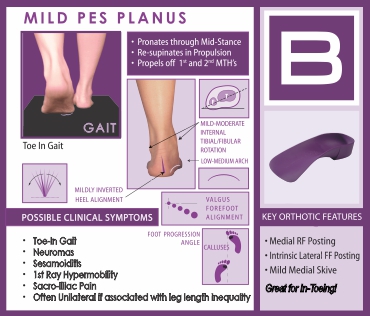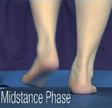



The B QUAD Foot-Type is a mildly over-pronated foot type or Mild Pes Planus. This is the result of a Compensated Rearfoot Varus with a flexible forefoot valgus deformity. It is often to be found unilateral and is often associated with a structural leg length discrepancy.
The B QUAD Foot-Type is a rarely occurring combined foot deformity, affecting less than 10% of the population. In addition, it is often unilateral. The B QUAD Foot-Type is a mildly over-pronated foot due to a compensated rearfoot varus deformity, however that over pronation is somewhat minimized by a forefoot valgus deformity that acts like a "pronation-deterrent".
In some cases, this foot-type may be caused by an acquired plantarflexed 1st ray, functioning as a forefoot valgus. This may occur in flexible pes planus foot types as the peroneals are working overtime to try and pull the forefoot into a pronatory twist in attempt to stabilize the midtarsal joint. It is also common to see this condition occur unilaterally on a short limb. Pronating the forefoot into a valgus alignment supinates the foot and helps lengthen the limb. When this foot-type occurs on one side only, we refer to this as a "foot disparity". When foot disparities occur, each foot functions differently from one another, as so each limb functions differently as well. This has a direct affect on the hips and low back, often leading to sacral-iliac pain. Heel and lower back pain is common. The torque foot nature of this foot-type allows the valgus forefoot to offset the uncompensated inverted heel alignment that would normally lead to a toe out gait pattern (see C Quad Foot-Type). Overall, the foot progression angle for this person is such that the feet point relatively straight ahead during gait (no toe out) with a narrow base of support, much like a tight rope walker.
All Quadrastep Orthotics are available in Regular and Narrow Widths, and with a topcover an an additional charge. For more information see Customized Orthotics.

• Sesamoiditis
• 1st Ray Hypermobility
• Sacroiliac Joint Pain
• Often unilateral, may be
associated with
leg length
discrepancies
 CONTACT
CONTACTPHASE |
 MIDSTANCE MIDSTANCEPHASE |
 PROPULSION PROPULSIONPHASE |
| MOUSE OVER THE PHASE FOR DETAILS OF THE B QUAD GAIT |
||
LIST OF RECOMMENDED SHOES BY QUAD
(Please refresh your browser often)
Having trouble selecting a Foot Type? Try our Easy Foot Typing Tool

Copyright ©2008-2024 Copyright QUADRASTEP SYSTEM® • Nolaro24™ LLC. All Rights Reserved
